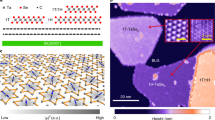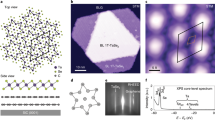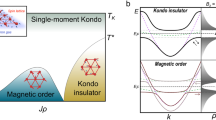Abstract
Quantum spin liquids are highly entangled, disordered magnetic states that are expected to arise in frustrated Mott insulators and to exhibit exotic fractional excitations such as spinons and chargons. Despite being electrical insulators, some quantum spin liquids are predicted to exhibit gapless itinerant spinons that yield metallic behaviour in the charge-neutral spin channel. We deposited isolated magnetic atoms onto single-layer 1T-TaSe2, a candidate gapless spin liquid, to probe how itinerant spinons couple to impurity spin centres. Using scanning tunnelling spectroscopy, we observe the emergence of new, impurity-induced resonance peaks at the 1T-TaSe2 Hubbard band edges when cobalt adatoms are positioned to have maximal spatial overlap with the local charge distribution. These resonance peaks disappear when the spatial overlap is reduced or when the magnetic impurities are replaced with nonmagnetic impurities. Theoretical simulations of a modified Anderson impurity model show that the observed peaks are consistent with a Kondo resonance induced by spinons combined with spin-charge binding effects that arise due to fluctuations of an emergent gauge field.
This is a preview of subscription content, access via your institution
Access options
Access Nature and 54 other Nature Portfolio journals
Get Nature+, our best-value online-access subscription
$29.99 / 30 days
cancel any time
Subscribe to this journal
Receive 12 print issues and online access
$209.00 per year
only $17.42 per issue
Buy this article
- Purchase on Springer Link
- Instant access to full article PDF
Prices may be subject to local taxes which are calculated during checkout





Similar content being viewed by others
References
Zhou, Y., Kanoda, K. & Ng, T.-K. Quantum spin liquid states. Rev. Mod. Phys. 89, 025003 (2017).
Balents, L. Spin liquids in frustrated magnets. Nature 464, 199–208 (2010).
Lee, P. A., Nagaosa, N. & Wen, X.-G. Doping a Mott insulator: physics of high-temperature superconductivity. Rev. Mod. Phys. 78, 17–85 (2006).
Savary, L. & Balents, L. Quantum spin liquids: a review. Rep. Prog. Phys. 80, 016502 (2016).
Motrunich, O. I. Variational study of triangular lattice spin-1/2 model with ring exchanges and spin liquid state in κ-(ET)2Cu2(CN)3. Phys. Rev. B 72, 045105 (2005).
Block, M. S., Sheng, D. N., Motrunich, O. I. & Fisher, M. P. A. Spin Bose-metal and valence bond solid phases in a spin-1/2 model with ring exchanges on a four-leg triangular ladder. Phys. Rev. Lett. 106, 157202 (2011).
He, W.-Y., Xu, X. Y., Chen, G., Law, K. T. & Lee, P. A. Spinon Fermi surface in a cluster Mott insulator model on a triangular lattice and possible application to 1T-TaS2. Phys. Rev. Lett. 121, 046401 (2018).
Lee, S.-S. & Lee, P. A. U(1) gauge theory of the Hubbard model: spin liquid states and possible application to κ-(BEDT−TTF)2Cu2(CN)3. Phys. Rev. Lett. 95, 036403 (2005).
Mross, D. F. & Senthil, T. Charge Friedel oscillations in a Mott insulator. Phys. Rev. B 84, 041102 (2011).
Yamashita, M. et al. Highly mobile gapless excitations in a two-dimensional candidate quantum spin liquid. Science 328, 1246–1248 (2010).
Shen, Y. et al. Evidence for a spinon Fermi surface in a triangular-lattice quantum-spin-liquid candidate. Nature 540, 559–562 (2016).
Paddison, J. A. M. et al. Continuous excitations of the triangular-lattice quantum spin liquid YbMgGaO4. Nat. Phys. 13, 117–122 (2017).
Klanjšek, M. et al. A high-temperature quantum spin liquid with polaron spins. Nat. Phys. 13, 1130–1134 (2017).
Yamashita, M. Boundary-limited and glassy-like phonon thermal conduction in EtMe3Sb[Pd(dmit)2]2. J. Phys. Soc. Jpn. 88, 083702 (2019).
Bourgeois-Hope, P. et al. Thermal conductivity of the quantum spin liquid candidate EtMe3Sb[Pd(dmit)2]2: no evidence of mobile gapless excitations. Phys. Rev. X 9, 041051 (2019).
Ni, J. M. et al. Absence of magnetic thermal conductivity in the quantum spin liquid candidate EtMe3Sb[Pd(dmit)2]2. Phys. Rev. Lett. 123, 247204 (2019).
Zhu, Z., Maksimov, P. A., White, S. R. & Chernyshev, A. L. Disorder-induced mimicry of a spin liquid in YbMgGaO4. Phys. Rev. Lett. 119, 157201 (2017).
Madhavan, V., Chen, W., Jamneala, T., Crommie, M. F. & Wingreen, N. S. Tunneling into a single magnetic atom: spectroscopic evidence of the Kondo resonance. Science 280, 567–569 (1998).
Hudson, E. W. et al. Interplay of magnetism and high-Tc superconductivity at individual Ni impurity atoms in Bi2Sr2CaCu2O8+δ. Nature 411, 920–924 (2001).
Ribeiro, P. & Lee, P. A. Magnetic impurity in a U(1) spin liquid with a spinon Fermi surface. Phys. Rev. B 83, 235119 (2011).
Hewson, A. C. The Kondo Problem to Heavy Fermions (Cambridge Univ. Press, 1993).
Gomilšek, M. et al. Kondo screening in a charge-insulating spinon metal. Nat. Phys. 15, 754–758 (2019).
Chen, Y. et al. Strong correlations and orbital texture in single-layer 1T-TaSe2. Nat. Phys. 16, 218–224 (2020).
Ruan, W. et al. Evidence for quantum spin liquid behaviour in single-layer 1T-TaSe2 from scanning tunnelling microscopy. Nat. Phys. 17, 1154–1161 (2021).
Ge, Y. & Liu, A. Y. First-principles investigation of the charge-density-wave instability in 1T-TaSe2. Phys. Rev. B 82, 155133 (2010).
Heinrich, A. J., Gupta, J. A., Lutz, C. P. & Eigler, D. M. Single-atom spin-flip spectroscopy. Science 306, 466–469 (2004).
Hirjibehedin, C. F., Lutz, C. P. & Heinrich, A. J. Spin coupling in engineered atomic structures. Science 312, 1021–1024 (2006).
Garnier, L. et al. The Kondo effect of a molecular tip as a magnetic sensor. Nano Lett. 20, 8193–8199 (2020).
Franchini, C., Reticcioli, M., Setvin, M. & Diebold, U. Polarons in materials. Nat. Rev. Mater. 6, 560–586 (2021).
Setvin, M. et al. Direct view at excess electrons in TiO2 rutile and anatase. Phys. Rev. Lett. 113, 086402 (2014).
Tütto, I. & Zawadowski, A. Quantum theory of local perturbation of the charge-density wave by an impurity: Friedel oscillations. Phys. Rev. B 32, 2449–2470 (1985).
Cai, P. et al. Visualizing the evolution from the Mott insulator to a charge-ordered insulator in lightly doped cuprates. Nat. Phys. 12, 1047–1051 (2016).
Ye, C. et al. Visualizing the atomic-scale electronic structure of the Ca2CuO2Cl2 Mott insulator. Nat. Commun. 4, 1365 (2013).
Okada, Y. et al. Imaging the evolution of metallic states in a correlated iridate. Nat. Mater. 12, 707–713 (2013).
Battisti, I. et al. Universality of pseudogap and emergent order in lightly doped Mott insulators. Nat. Phys. 13, 21–25 (2017).
Zhao, H. et al. Atomic-scale fragmentation and collapse of antiferromagnetic order in a doped Mott insulator. Nat. Phys. 15, 1267–1272 (2019).
Yan, Y. J. et al. Electron-doped Sr2IrO4: an analogue of hole-doped cuprate superconductors demonstrated by scanning tunneling microscopy. Phys. Rev. X 5, 041018 (2015).
Sun, Z. et al. Evidence for a percolative Mott insulator–metal transition in doped Sr2IrO4. Phys. Rev. Res. 3, 023075 (2021).
Cho, D., Cho, Y.-H., Cheong, S.-W., Kim, K.-S. & Yeom, H. W. Interplay of electron–electron and electron–phonon interactions in the low-temperature phase of 1T−TaS2. Phys. Rev. B 92, 293602 (2015).
Zhu, X.-Y. et al. Realization of a metallic state in 1T-TaS2 with persisting long-range order of a charge density wave. Phys. Rev. Lett. 123, 206405 (2019).
Qiao, S. et al. Mottness collapse in 1T−TaS2−xSex transition-metal dichalcogenide: an interplay between localized and itinerant orbitals. Phys. Rev. X 7, 041054 (2017).
Madhavan, V., Chen, W., Jamneala, T., Crommie, M. F. & Wingreen, N. S. Local spectroscopy of a Kondo impurity: Co on Au(111). Phys. Rev. B 64, 165412 (2001).
Kim, B. J. et al. Distinct spinon and holon dispersions in photoemission spectral functions from one-dimensional SrCuO2. Nat. Phys. 2, 397–401 (2006).
Florens, S. & Georges, A. Quantum impurity solvers using a slave rotor representation. Phys. Rev. B 66, 165111 (2002).
He, W.-Y. & Lee, P. A. Magnetic impurity as a local probe of the U(1) quantum spin liquid with spinon Fermi surface. Phys. Rev. B 105, 195156 (2022).
Florens, S. & Georges, A. Slave-rotor mean-field theories of strongly correlated systems and the Mott transition in finite dimensions. Phys. Rev. B 70, 035114 (2004).
Fano, U. Effects of configuration interaction on intensities and phase shifts. Phys. Rev. 124, 1866–1878 (1961).
Wen, X.-G. & Lee, P. A. Theory of underdoped cuprates. Phys. Rev. Lett. 76, 503–506 (1996).
Lee, P. A., Nagaosa, N., Ng, T.-K. & Wen, X.-G. SU(2) formulation of the t–J model: application to underdoped cuprates. Phys. Rev. B 57, 6003–6021 (1998).
Nagaosa, N. Quantum Field Theory in Strongly Correlated Electronic Systems (Springer, 1999).
Dhochak, K., Shankar, R. & Tripathi, V. Magnetic impurities in the honeycomb Kitaev model. Phys. Rev. Lett. 105, 117201 (2010).
Vojta, M., Mitchell, A. K. & Zschocke, F. Kondo impurities in the Kitaev spin liquid: numerical renormalization group solution and gauge-flux-driven screening. Phys. Rev. Lett. 117, 037202 (2016).
Banerjee, A. et al. Neutron scattering in the proximate quantum spin liquid α-RuCl3. Science 356, 1055–1059 (2017).
Janša, N. et al. Observation of two types of fractional excitation in the Kitaev honeycomb magnet. Nat. Phys. 14, 786–790 (2018).
Wang, L., Maxisch, T. & Ceder, G. Oxidation energies of transition metal oxides within the GGA + U framework. Phys. Rev. B 73, 195107 (2006).
de la Peña O’Shea, V. A., Moreira, I. D. P. R., Roldán, A. & Illas, F. Electronic and magnetic structure of bulk cobalt: the α, β, and ε-phases from density functional theory calculations. J. Chem. Phys. 133, 024701 (2010).
Acknowledgements
This research was supported by the US Department of Energy, Office of Science, National Quantum Information Science Research Centers, Quantum Systems Accelerator (STM/STS measurements) and the Advanced Light Source (sample growth) funded by the Director, Office of Science, Office of Basic Energy Sciences, Materials Sciences and Engineering Division, of the US Department of Energy under contract no. DE-AC02-05CH11231. Support was also provided by National Science Foundation awards DMR-2221750 (topographic characterization) and DMR-1926004 (DFT calculations). The work at the Stanford Institute for Materials and Energy Sciences and Stanford University (surface treatment) was supported by the DOE Office of Basic Energy Sciences, Division of Material Science. P.A.L. acknowledges support from DOE Basic Energy Science award number DE-FG02-03ER46076 (theoretical QSL analysis). H.R. acknowledges support from a National Research Foundation of Korea grant funded by the government of Korea (MSIT) (no. 2021R1A2C2014179) (growth characterization). W.R. acknowledges fellowship support from Shanghai Science and Technology Development Funds (no. 22QA1400600).
Author information
Authors and Affiliations
Contributions
Y.C., W.R., P.A.L. and M.F.C. initiated and conceived this project. Y.C., W.R., R.L.L., T.Z. and C.Z. carried out STM/STS measurements under the supervision of M.F.C. J.H., S.T. and H.R. performed sample growth under the supervision of Z.-X.S. and S.-K.M. W.Y.H. performed slave-rotor calculations and theoretical analysis under the supervision of P.A.L. M.W. performed DFT calculations under the supervision of S.G.L. Y.C., W.Y.H., W.R., P.A.L. and M.F.C. wrote the manuscript with the help from all authors. All authors contributed to the scientific discussion.
Corresponding author
Ethics declarations
Competing interests
The authors declare no competing interests.
Peer review
Peer review information
Nature Physics thanks Elio Koenig and the other, anonymous, reviewer(s) for their contribution to the peer review of this work.
Additional information
Publisher’s note Springer Nature remains neutral with regard to jurisdictional claims in published maps and institutional affiliations.
Supplementary information
Supplementary Information
Supplementary Notes 1–3 and Figs. 1–9.
Supplementary Data 1
Code for simulations of Fig. 4.
Supplementary Data 2
Code for simulations of Fig. 5c.
Supplementary Data 3
Code for simulations of Fig. 5d.
Supplementary Data 4
Code for simulations of Fig. S6a–c.
Supplementary Data 5
Code for simulations of Fig. S6d.
Supplementary Data 6
Code for simulations of Fig. S7.
Supplementary Data 7
Code for simulations of Fig. S8.
Supplementary Data 8
Code for simulations of Fig. S9.
Source data
Source Data Fig. 1
Raw data for Fig. 1d.
Source Data Fig. 2
Raw data for Fig. 2e.
Source Data Fig. 3
Raw data for Fig. 3.
Source Data Fig. 4
Raw data for Fig. 4.
Source Data Fig. 5
Raw data for Fig. 5.
Rights and permissions
Springer Nature or its licensor holds exclusive rights to this article under a publishing agreement with the author(s) or other rightsholder(s); author self-archiving of the accepted manuscript version of this article is solely governed by the terms of such publishing agreement and applicable law.
About this article
Cite this article
Chen, Y., He, WY., Ruan, W. et al. Evidence for a spinon Kondo effect in cobalt atoms on single-layer 1T-TaSe2. Nat. Phys. 18, 1335–1340 (2022). https://doi.org/10.1038/s41567-022-01751-4
Received:
Accepted:
Published:
Issue Date:
DOI: https://doi.org/10.1038/s41567-022-01751-4
This article is cited by
-
Controlling structure and interfacial interaction of monolayer TaSe2 on bilayer graphene
Nano Convergence (2024)
-
Quantum spin liquid signatures in monolayer 1T-NbSe2
Nature Communications (2024)
-
Strong correlations in two-dimensional transition metal dichalcogenides
Science China Physics, Mechanics & Astronomy (2023)



